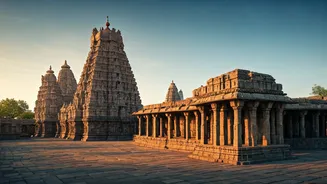Chittorgarh Fort: Rajasthan's Pride
Chittorgarh Fort, located in Rajasthan, stands as a symbol of Rajput valor and sacrifice. This vast fort complex is more than 500 years old, and it has
witnessed numerous battles and sieges. The fort houses several historical structures, including the Vijay Stambh (Victory Tower) and the Kirti Stambh (Tower of Fame), each bearing intricate carvings and architectural marvels. The fort's strategic location and formidable defenses made it a crucial site for the Rajput rulers. It is a UNESCO World Heritage site, and it continues to draw visitors who come to admire its beauty and to learn about the courage of the Rajput warriors. The fort's history is steeped in tales of heroism, including the legendary jauhar, the self-immolation of Rajput women to avoid capture by enemy forces.
Agra Fort: Mughal Grandeur
Agra Fort, a UNESCO World Heritage site, exemplifies the architectural splendor of the Mughal Empire. Constructed in the 16th century, it served as the primary residence of the Mughal emperors. The fort showcases a blend of Persian and Indian architectural styles, with its imposing red sandstone walls, intricate marble work, and grand halls. Within its walls lie several significant structures, including the Jahangir Mahal, Diwan-i-Aam (Hall of Public Audience), and Diwan-i-Khas (Hall of Private Audience). Agra Fort stands as a testament to the Mughals' power, artistry, and vision. It provides an insight into the lives of the emperors and the opulence of the Mughal court, and it remains a prominent landmark in India's historical landscape.
Hampi: Vijayanagara Legacy
Hampi, located in Karnataka, was the capital of the Vijayanagara Empire, a powerful empire that flourished in the 14th to 16th centuries. The ruins of Hampi showcase a unique architectural style, blending Dravidian and Indo-Islamic influences. The city is a UNESCO World Heritage site, featuring numerous temples, palaces, and market streets. The Virupaksha Temple, the Vittala Temple with its iconic stone chariot, and the Queen's Bath are among the major attractions. Hampi's landscape, dotted with massive boulders and ancient ruins, creates a surreal atmosphere, reflecting the empire's wealth and cultural achievements. Visiting Hampi is like stepping back in time to experience the grandeur and artistry of the Vijayanagara Empire.
Konark Sun Temple: Odisha's Marvel
The Konark Sun Temple in Odisha, dating back to the 13th century, is a masterpiece of Indian architecture. The temple, dedicated to the Sun God, is designed in the shape of a colossal chariot, with intricate carvings depicting mythological scenes, daily life, and various deities. Its massive stone wheels, once functional, are considered architectural wonders. The temple, a UNESCO World Heritage site, is renowned for its sculptural detail and unique design. The exquisite carvings and the overall layout of the temple reflect the artistic brilliance of the Kalinga dynasty. The Konark Sun Temple continues to attract visitors from around the world, who come to admire its beauty and to appreciate its historical significance.
Meenakshi Amman Temple: Tamil Nadu's Gem
The Meenakshi Amman Temple in Madurai, Tamil Nadu, is a vibrant example of Dravidian architecture. This ancient temple complex is dedicated to the goddess Meenakshi and her consort, Sundareswarar. The temple's towering gopurams (gateway towers), adorned with colorful sculptures, are a visual spectacle. The temple's history dates back centuries, and it has undergone several expansions and renovations. The complex is a major pilgrimage site and a center of cultural activity. The intricate carvings, the vibrant colors, and the overall atmosphere of the Meenakshi Amman Temple reflect the rich traditions and the spiritual devotion of the people of Tamil Nadu. The temple remains a significant cultural landmark, drawing devotees and visitors alike.














